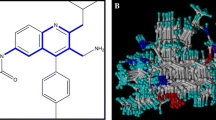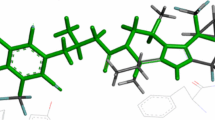Abstract
The inhibition of dipeptidyl peptidase IV (DPP-IV) has emerged as an attractive target in the treatment of type 2 diabetes. In view of this development, a critical analysis of structural requirements of the DPP-IV inhibitors is envisioned to identify the significant features toward design of selective inhibitors. The comparative molecular field analysis (CoMFA) and comparative molecular similarity indices analysis (CoMSIA) contour plots of pyrrolidine based analogues are used to analyze the structural requirements of a DPP-IV active site. The CoMFA model has shown a cross-validated q 2 of 0.651 with a non-cross-validated r 2 of 0.882 and explained 70.6% variance in the activity of external test compounds. In this, the steric and electrostatic fields have respectively contributed 59.8 and 40.2%, respectively, to the explained activity of the compounds. The CoMSIA model has shown optimum predictivity (cross-validated q 2 = 0.661; non-cross-validated r 2 = 0.803; external test set’s predictive r 2 = 0.706) with four molecular fields namely, steric, electrostatic, hydrogen bond (HB)-donor, and HB-acceptor. The contour plots of molecular fields resulting from these studies have suggested: (i) steric restriction with small electron rich substituent at 2- and 3-position of pyrrolidine ring, (ii) presence of electropositive ring linker between the pyrrolidine head and aryl tail, (iii) presence of electron-rich groups around the aryl tail moiety, and (iv) presence of sulfonamide between the ring linker and aryl tail which would increase DPP-IV binding affinity of the compounds. These findings will help in the design of structurally related/new compounds as potential DPP-IV inhibitors.
Similar content being viewed by others
Abbreviations
- CoMFA:
-
Comparative molecular field analysis
- CoMSIA:
-
Comparative molecular similarity indices analysis
- GLP-1:
-
Glucagon-like peptide 1
- DPP:
-
Dipeptidyl peptidase
- PLS:
-
Partial least-squares
References
Creutzfeldt W (1979) The incretin concept today. Diabetologia 16: 75–85. doi:10.1007/BF01225454
Knudsen LB (2004) Glucagon-like peptide-1: the basis of a new class of treatment for type 2 diabetes. J Med Chem 47: 4128–4134. doi:10.1021/jm030630m
Weber AE (2004) Dipeptidyl peptidase IV Inhibitors for the treatment of diabetes. J Med Chem 47: 4135–4141. doi:10.1021/jm030628v
Augustyns K, Van der Veken P, Senten K, Haemers A (2005) The therapeutic potential of inhibitors of dipeptidyl peptidase IV (DPP IV) and related proline-specific dipeptidyl aminopeptidases. Curr Med Chem 12: 971–998. doi:10.2174/0929867053507298
Augustyns K, Van der Veken P, Haemers A (2005) Inhibitors of proline-specific dipeptidyl peptidases: DPP-IV inhibitors as novel approach for the treatment of type 2 diabetes. Expert Opin Ther Pat 15: 1387–1407. doi:10.1517/13543776.15.10.1387
Geldern TWV, Trevillyan JM (2006) ‘The next big thing’ in diabetes: clinical progress on DPP-IV Inhibitors. Drug Dev Res 67: 627–642. doi:10.1002/ddr.20138
Orskov C (1992) Glucagon-like peptide-1, a new hormone of the entero-insular axis. Diabetologia 35: 701–711. doi:10.1007/BF00429088
Zander M, Madsbad S, Madsen JL, Holst JJ (2002) Effect of 6-week course of glucagon-like peptide 1 on glycaemic control, insulin sensitivity, and β-cell function in type 2 diabetes: a parallel-group study. Lancet 359: 824–830. doi:10.1016/S0140-6736(02)07952-7
Meier JJ, Nauck MA (2005) Glucagon-like peptide 1 (GLP-1) in biology and pathology. Diabetes Metab Res Rev 21: 91–117. doi:10.1002/dmrr.538
Combettes MMJ (2006) GLP-1 and type 2 diabetes: physiology and new clinical advances. Curr Opin Pharm 6: 598–605. doi:10.1016/j.coph.2006.08.003
Havale SH, Pal M (2009) Medicinal chemistry approaches to the inhibition of dipeptidyl peptidase-4 for the treatment of type 2 diabetes. Bioorg Med Chem Lett 17: 1783–1802. doi:10.1016/j.bmc.2009.01.061
Hansch C (1981) The physicochemical approach to drug design and discovery (QSAR). Drug Dev Res 1: 267–309. doi:10.1002/ddr.430010403
Kubinyi H (1997) QSAR and 3D-QSAR in drug design. Part 1: methodology. Drug Discov Today 2: 457–467. doi:10.1016/S1359-6446(97)01079-9
Murugesan V, Prabhakar YS, Katti SB (2009) CoMFA and CoMSIA studies on thiazolidin-4-one as anti-HIV-1 agents. J Mol Graph Model 27: 735–743. doi:10.1016/j.jmgm.2008.11.006
Pissurlenkar RRS, Shaikh MS, Coutinho EC (2007) 3D-QSAR studies of dipeptidyl peptidase IV inhibitors using a docking based alignment. J Mol Model 13: 1047–1071. doi:10.1007/s00894-007-0227-2
Zeng J, Liu G, Tang Y, Jiang H (2007) 3D-QSAR studies on fluoropyrrolidine amides as dipeptidyl peptidase IV inhibitors by CoMFA and CoMSIA. J Mol Model 13: 993–1000. doi:10.1007/s00894-007-0221-8
Kang NS, Ahn JH, Kim SS, Chae CH, Yoo SE (2007) Docking-based 3D-QSAR study for selectivity of DPP4, DPP8, and DPP9 inhibitors. Bioorg Med Chem Lett 17: 3716–3721. doi:10.1016/j.bmcl.2007.04.031
Gao YD, Feng D, Sheridan RP, Scapin G, Patel SB, Wu JK, Zhang X, SinhaRoy R, Thornberry NA, Weberb AE, Biftu T (2007) Modeling assisted rational design of novel, potent, and selective pyrrolopyrimidine DPP-4 inhibitors. Bioorg Med Chem Lett 17: 3877–3879. doi:10.1016/j.bmcl.2007.04.106
Parmee ER, He J, Mastracchio A, Edmondson SD, Colwell L, Eiermann G, Feeney WP, Habulihaz B, He H, Kilburn R, Leiting B, Lyons K, Marsilio F, Patel RA, Petrov A, Di Salvo J, Wu JK, Thornberry NA, Weber AE (2004) 4-Amino cyclohexylglycine analogues as potent dipeptidylpeptidase IV inhibitors. Bioorg Med Chem Lett 14: 43–46. doi:10.1016/j.bmcl.2003.10.016
Ashton WT, Dong H, Sisco RM, Doss GA, Leiting B, Patel RA, Wu JK, Marsilio F, Thornberry NA, Weber AE (2004) Diastereoselective synthesis and configuration-dependent activity of (3-substituted-cycloalkyl)glycine pyrrolidides and thiazolidides as dipeptidyl peptidase IV inhibitors. Bioorg Med Chem Lett 14: 859–863. doi:10.1016/j.bmcl.2003.12.013
Lu IL, Lee SJ, Tsu H, Wu SY, Kao KH, Chien CH, Chang YY, Chen YS, Cheng JH, Chang CN, Chen TW, Chang SP, Chen X, Jiaang WT (2005) Glutamic acid analogues as potent dipeptidyl peptidase IV and 8 inhibitors. Bioorg Med Chem Lett 15: 3271–3275. doi:10.1016/j.bmcl.2005.04.051
Xu J, Wei L, Mathvink R, Edmondson SD, Mastracchio A, Eiermann GJ, He H, Leone JF, Leiting B, Lyons KA, Marsilio F, Patel RA, Petrov A, Wu JK, Thornberry NA, Weber AE (2006) Discovery of potent, selective, and orally bioavailable pyridone-based dipeptidyl peptidase-4 inhibitors. Bioorg Med Chem Lett 16: 1346–1349. doi:10.1016/j.bmcl.2005.11.052
Xu J, Wei L, Mathvink RJ, Edmondson SD, Eiermann GJ, He H, Leone JF, Leiting B, Lyons KA, Marsilio F, Patel RA, Patel SB, Petrov A, Scapin G, Wu JK, Thornberry NA, Weber AE (2006) Discovery of potent, selective, and orally bioavailable oxadiazole-based dipeptidyl peptidase IV Inhibitors. Bioorg Med Chem Lett 16: 5373–5377. doi:10.1016/j.bmcl.2006.07.061
Edmondson SD, Mastracchio A, Mathvink RJ, He J, Harper B, Park YJ, Beconi M, Di Salvo J, Eiermann GJ, He H, Leiting B, Leone JF, Levorse DA, Lyons K, Patel RA, Patel SB, Petrov A, Scapin G, Shang J, Roy RS, Smith A, Wu JK, Xu S, Zhu B, Thornberry NA, Weber AE (2006) (2S,3S)-3-amino-4-(3,3-difluoropyrrolidin-1-yl)-N, N-dimethyl-4- oxo-2- (4 -[1, 2, 4]triazolo [1,5-a]-pyridin-6-ylphenyl)butanamide: a selective α-amino amide dipeptidyl peptidase IV inhibitor for the treatment of type 2 diabetes. J Med Chem 49: 3614–3627. doi:10.1021/jm060015t
Duffy JL, Kirk BA, Wang L, Eiermann GJ, He H, Leiting B, Lyons KA, Patel RA, Patel SB, Petrov A, Scapin G, Wu JK, Thornberry NA, Weber AE (2007) 4-Aminophenylalanine and 4-aminocyclohexylalanine derivatives as potent, selective, and orally bioavailable inhibitors of dipeptidyl peptidase IV. Bioorg Med Chem Lett 17: 2879–2885. doi:10.1016/j.bmcl.2007.02.066
Leiting B, Pryor KD, Wu JK, Marsilio F, Patel RA, Craik CS, Ellman JA, Cummings RT, Thornberry NA (2003) Catalytic properties and inhibition of proline-specific dipeptidyl peptidases II, IV and VII. Biochem J 371: 525–532. doi:10.1042/BJ20021643
MOE: The Molecular Operating Environment from Chemical Computing Group Inc., 1255 University Street, Suite 1600, Montreal, Quebec, Canada H3B 3X3
SYBYL, version 7.3; Tripos associates. St. Louis, MO, USA, 2006
Clark M, Cramer RD III, Opdenbosch NV (1989) Validation of the general purpose tripos 5.2 force field. J Comput Chem 10: 982–1012. doi:10.1002/jcc.540100804
Nyburg SC (1974) Some uses of a best molecular fit routine. Acta Crystallogr B 30: 251–253. doi:10.1107/S0567740874002603
Cramer RD III, Patterson DE, Bunce JD (1988) Comparative molecular field analysis (CoMFA). 1. Effect of shape on binding of steroids to carrier proteins. J Am Chem Soc 110: 5959–5967. doi:10.1021/ja00226a005
Klebe G, Abraham U, Mietzner T (1994) Molecular similarity indices in a comparative analysis (CoMSIA) of drug molecules to correlate and predict their biological activity. J Med Chem 37: 4130–4146. doi:10.1021/ja00226a005
Stahle L, Wold S (1988) 6 Multivariate data analysis and experimental design in biomedical research. Prog Med Chem 25: 291–338. doi:10.1016/S0079-6468(08)70281-9
Cramer RD III, Bunce JD, Patterson DE, Frank IE (1988) Crossvalidation, bootstrapping, and partial least squares compared with multiple regression in conventional QSAR studies. Quant Struct Act Relat 7: 18–25. doi:10.1002/qsar.19880070105
Golbraikh A, Tropsha A (2002) Beware of q2. J Mol Graph Model 20: 269–276. doi:10.1016/S1093-3263(01)00123-1
Author information
Authors and Affiliations
Corresponding author
Electronic Supplementary Material
The Below is the Electronic Supplementary Material.
Rights and permissions
About this article
Cite this article
Murugesan, V., Sethi, N., Prabhakar, Y.S. et al. CoMFA and CoMSIA of diverse pyrrolidine analogues as dipeptidyl peptidase IV inhibitors: active site requirements. Mol Divers 15, 457–466 (2011). https://doi.org/10.1007/s11030-010-9267-0
Received:
Accepted:
Published:
Issue Date:
DOI: https://doi.org/10.1007/s11030-010-9267-0




